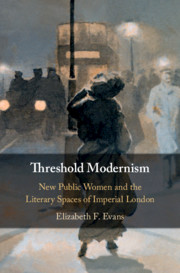
-
Select format
-
- Publisher:
- Cambridge University Press
- Publication date:
- 30 November 2018
- 06 December 2018
- ISBN:
- 9781108632812
- 9781108479813
- 9781108466608
- Dimensions:
- (228 x 152 mm)
- Weight & Pages:
- 0.58kg, 274 Pages
- Dimensions:
- (229 x 152 mm)
- Weight & Pages:
- 0.4kg, 273 Pages
- Subjects:
- Literature, English Literature 1900-1945
You may already have access via personal or institutional login- Subjects:
- Literature, English Literature 1900-1945
Book description
Threshold Modernism reveals how changing ideas about gender and race in late nineteenth- and early twentieth-century Britain shaped - and were shaped by - London and its literature. Chapters address key sites, especially department stores, women's clubs, and city streets, that coevolved with controversial types of modern women. Interweaving cultural history, narrative theory, close reading, and spatial analysis, Threshold Modernism considers canonical figures such as George Gissing, Henry James, Dorothy Richardson, H. G. Wells, and Virginia Woolf alongside understudied British and colonial writers including Amy Levy, B. M. Malabari, A. B. C. Merriman-Labor, Duse Mohamed Ali, and Una Marson. Evans argues that these diverse authors employed the 'new public women' and their associated spaces to grapple with widespread cultural change and reflect on the struggle to describe new subjects, experiences, and ways of seeing in appropriately novel ways. For colonial writers of color, those women and spaces provided a means through which to claim their own places in imperial London.
Reviews
'The book’s arguments are clear and forceful. The recovery of reverse imperial ethnography adds historical depth to treatments of race in London that too often begin with materials published after the Second World War. The book will be of interest to a wide variety of readers, from academic specialists in modernism, British literature, women’s literature, and postcolonial literature and to advanced students in courses on British modernism, literature and the city, and women’s writing.'
Michael Thurston - Smith College, Massachusetts
'This is a well-conceived and deftly executed analysis of women’s changing position in late nineteenth- and early twentieth-century London, as represented in a wide range of literary texts. It offers useful new methodologies for literary study, drawing particularly on new scholarly approaches in feminist geography and digital humanities, and is fresh and original in its insights.'
Lise Sanders - Hampshire College, Massachusetts
'Everyone loves a book with maps. Evans has mapped out sites of narrative significance in Henry James' The Princess Casamassima, Amy Levy's The Romance of a Shop, George Gissing's The Odd Women, H. G. Wells' Ann Veronica and Virginia Woolf's Night and Day.'
Rebecca Bowler Source: Times Higher Education
'Evans contributes to the ongoing debate on the nature and definition, and quantity of modernisms, revealing 'overlooked commonalities' even between H. G. Wells and Virginia Woolf. In advancing her arguments, Evans employs maps, spatial theory and work from understudied colonial writers of colour who gazed with outsiders’ eyes on the teeming imperial metropolis; and she asks us to re-examine literary scholarship with fresh eyes, too.'
Source: The Times Literary Supplement
Contents
Metrics
Altmetric attention score
Full text views
Full text views help Loading metrics...
Loading metrics...
* Views captured on Cambridge Core between #date#. This data will be updated every 24 hours.
Usage data cannot currently be displayed.
Accessibility standard: Unknown
Why this information is here
This section outlines the accessibility features of this content - including support for screen readers, full keyboard navigation and high-contrast display options. This may not be relevant for you.
Accessibility Information
Accessibility compliance for the PDF of this book is currently unknown and may be updated in the future.


